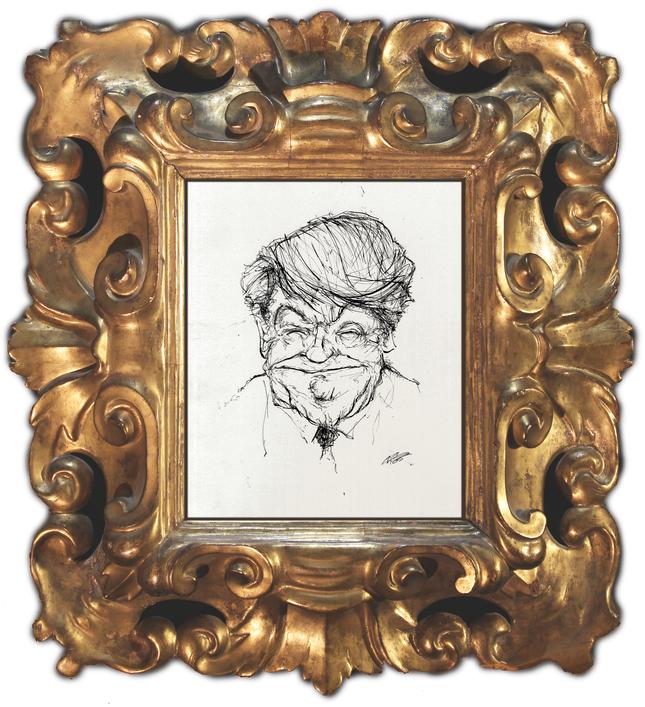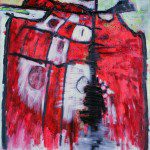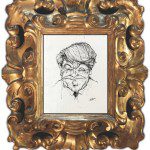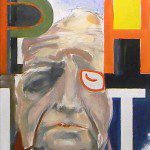‘High Art | Low Art’ on Book Hill
By • May 19, 2016 0 2601

The weather cleared up and the crowds turned out for the annual Spring Art Walk in Georgetown’s Book Hill section last Friday. One of the half-dozen exhibitions that welcomed visitors that night, in a pop-up space at 1666 33rd St. NW, is called “High Art | Low Art: Works by David Richardson and Ari Post.”
(There will be another open-house reception at the gallery with Richardson and Post on Friday May 20, from 5 – 9p.m.)
The two artists, who met in a Dupont Circle art gallery in 2009, are unlikely colleagues: a Marine Corps Lieutenant who was deployed to Iraq and Afghanistan and a manager of curatorial programs for the Smithsonian’s Freer and Sackler Galleries (Post, art critic for The Georgetowner, is the latter).
The first two rooms contain eight large paintings and one small one from Richardson’s “Trojan War Series”: abstract oils that suggest Richard Diebenkorn in their varied combinations of lines and planes and Mark Rothko in their strong, layered colors. A distorted tic-tac-toe motif that at times seems to transform into landscape is rooted in the Japanese stone markers that inspired an earlier series by Richardson.
Other than the series title and the names of the paintings — for example, “Achilles Seeking Kleos” — the signs that these works are about the experience of combat are, literally, signs (they could be considered sculptures but are not identified as such). Three quotes are painted on groupings of boards on the walls. And powerful Diomedes/froze him with a Glance/”Not a word of retreat./You’ll Never Persuade me…” reads one, one phrase per board. In the center of the second room stands a stanchion — a charred board, with text painted on one side and the locations of battles on the other, set vertically in cement with a military knife for a pinnacle.
The remaining room on the first floor displays Post’s work in several media. Two painted portraits are simultaneously decorative and aggressive, with hints of both Henri Matisse and Alice Neel. In between them is the hard-to-look-away-from “Plisa,” a dense clustering of more than 200 small heads, somber white faces bordered by shadows in charcoal and India ink. It brings to mind the Holocaust and, in fact, is named for the Lithuanian village of Post’s ancestors.
On the opposite wall are pairs of animal illustrations. In each case, the ink drawing and the linoblock print are so dissimilar — not only in medium but in style — that one would never guess they were by the same artist (never mind by the creator of the portraits and “Plisa”). In several of the linoblocks, the strokes within the animal’s outline are not meant to represent its hide, instead resembling the patterns of paper-cut art.
The ink drawings — storybook animals — are preparation for what you’ll find upstairs. Post, who calls newspaper comics and political cartoons “his first true loves,” has drawn caricatures, mounted in gilt frames, of would-be presidential nominees Clinton, Cruz, Kasich, Sanders and Trump. Surrounding them is a series of 34 small drawings titled “The Four Humors, and Other Temperaments,” which could have come from the pen of Richard Thompson, creator of “Cul de Sac” in the Washington Post.
These illustrations, however, are from the Ari Post, a virtual newspaper intended, yes, to entertain us, but also to help us face our true and often neurotic natures. Post has taken the ancient theory of the four humors, believed for centuries to determine the moods and character types of individuals, to a new level of subtlety (with a good dash of irony).
Among the titles of his cartoon snapshots: “Confronting one’s inherent banality,” “Hungry, but not really hungry” and (under what is perhaps a portrait of the artist as a young man) “Misplaced guilt which, like a phantom limb, is but the tingling reminder of having renounced your Jewish faith.”
In the other room on the second floor are earlier works by Richardson that incorporate symbols such as skulls, Statues of Liberty and Uncle Sams. There are also three reproductions of a signboard for, presumably, a gym in Ramadi, showing an Iraqi barbell-lifter. To recreate its destruction by street gunfire, which he witnessed in 2006, Richardson took a shotgun to the three paintings, blowing away half of the third.
One of Post’s most impressive works is in that room, a tall, narrow painting with five heads stacked vertically. Perhaps referencing a strip of movie frames or photo-booth pictures, it is a portrait of painter Philip Guston, an Abstract Expressionist who later adopted a cartoonish representational style. Each head, bordered by the four letters of the subject’s name, “Phil,” is colored differently, two only in yellow on the white canvas.
Note: There will be another reception with Richardson and Post this Friday, May 20, from 5 to 9 p.m.
- “Make America Great Again,” one of Post’s presidential-nominee caricatures. | Courtesy of the artist.




